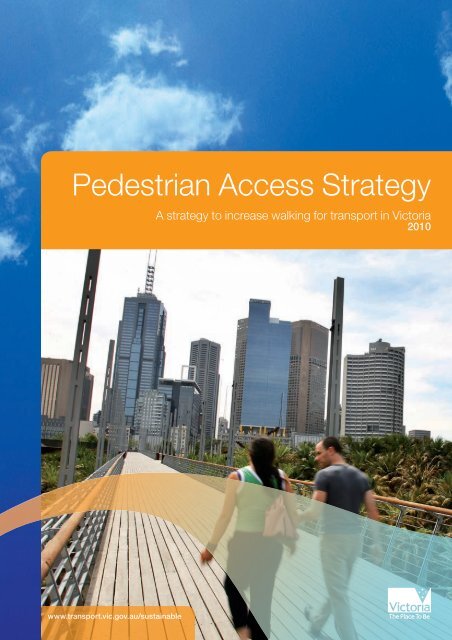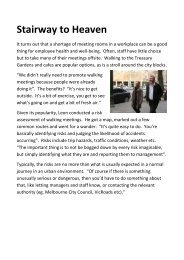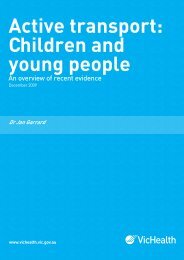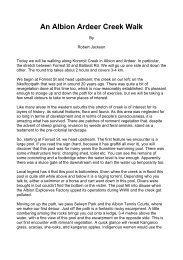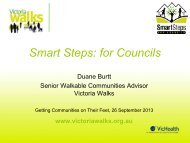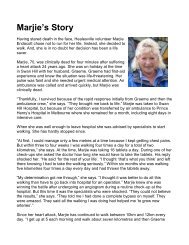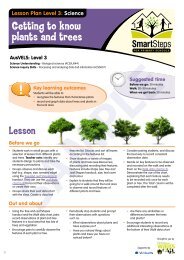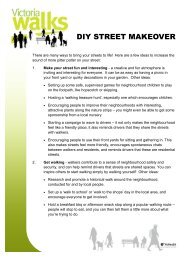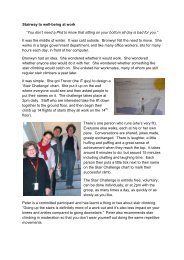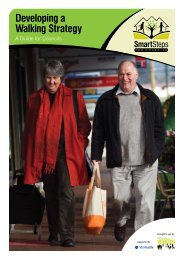Pedestrian Access Strategy 2010 - Victoria Walks
Pedestrian Access Strategy 2010 - Victoria Walks
Pedestrian Access Strategy 2010 - Victoria Walks
You also want an ePaper? Increase the reach of your titles
YUMPU automatically turns print PDFs into web optimized ePapers that Google loves.
<strong>Pedestrian</strong> <strong>Access</strong> <strong>Strategy</strong>A strategy to increase walking for transport in <strong>Victoria</strong><strong>2010</strong>www.transport.vic.gov.au/sustainable
The <strong>Pedestrian</strong> <strong>Access</strong> <strong>Strategy</strong>ContentsMinister’s Foreword 31. Executive Summary: Stepping in the right direction 42. Introduction: The importance of GOOD <strong>Pedestrian</strong> <strong>Access</strong> 73. encouraging walking in <strong>Victoria</strong> 104. Where we are 124.1 Government responsibility for walking in <strong>Victoria</strong> 134.2 What we’ve done so far 134.3 How walking fits with <strong>Victoria</strong>n Government activities 155. Walking in <strong>Victoria</strong>: a snapshot 176. Working together to encourage walking 25Strategic Direction 1 – encourage walking by changingattitudes and behaviour 27Strategic Direction 2 – Collaborate to improve provisionfor walking 30Strategic Direction 3 – Create pedestrian friendly builtenvironments, streets and public spaces 33Strategic Direction 4 – Increase the safety of walking 36Strategic Direction 5 – Continue Integrating walking withpublic transport 397. Making it happen: implementing the <strong>Pedestrian</strong> <strong>Access</strong> <strong>Strategy</strong> 41<strong>Pedestrian</strong> <strong>Access</strong> <strong>Strategy</strong> | Page 1 of 44 pages
Page 2 of 44 pages | The <strong>Pedestrian</strong> <strong>Access</strong> <strong>Strategy</strong>Minister’s Foreword
Walking is the most basic form of transport, and yet many of us aren’twalking enough.In our time-pressured lives, we have undervalued the most fundamentalway of getting from A to B.The <strong>Pedestrian</strong> <strong>Access</strong> <strong>Strategy</strong> is a plan for pedestrians – to get more ofus walking on an improved network of paths in our cities, towns andneighbourhoods.While motivated by the need to reduce congestion and improve transportefficiency, the benefits of making our neighbourhoods more walkable will bea healthier population and a safer and cleaner environment.The <strong>Pedestrian</strong> <strong>Access</strong> <strong>Strategy</strong> considers the reasons behind a significantdrop in the number of people who walk to work and school since the 1970s.For more than 30 years there has been a marked decline in the number ofpeople walking in <strong>Victoria</strong>. Understanding why we aren’t walking more iscritical to turning this around, building on upward trends now appearing.The <strong>Pedestrian</strong> <strong>Access</strong> <strong>Strategy</strong> looks at ways we can partner with localgovernment to promote walking as a top of mind choice for busy people,especially for short trips and in combination with public transport.It sets out the steps to deliver more pedestrian-friendly public spaces thatare safe for walking, and better connections with trains, trams and buses tomake public transport the easiest travel choice.By valuing walking as an important mode of transport, we can encouragemore <strong>Victoria</strong>ns to walk more often.Tim Pallas MPMinister for Roads and PortsThe <strong>Pedestrian</strong> <strong>Access</strong> <strong>Strategy</strong> | Page 3 of 44 pages
1 | executive summary: stepping in the right direction1SteppingEXECUTIVE SUMMARYin the right directionPage 4 of 44 pages | The <strong>Pedestrian</strong> <strong>Access</strong> <strong>Strategy</strong>
1 | executive summary: stepping in the right directionBetter <strong>Pedestrian</strong> <strong>Access</strong>The <strong>Pedestrian</strong> <strong>Access</strong> <strong>Strategy</strong> sets out five strategicdirections to prioritise future actions. These are drawnfrom consultations with stakeholders including localcouncils and consideration of the walking trends of <strong>Victoria</strong>ns.The strategic directions and first steps for action will provideguidance to both state and local government during thestrategy’s implementation.The <strong>Victoria</strong>n Government’s strategic directions for walkingare to:1. Encourage people to walk by changing attitudesand behaviour. This aims to make walking the top‐of‐mindchoice for <strong>Victoria</strong>ns – especially for short trips – bymaking walking for transport a visible and valued partof‐daily life.Key actions are:• Integrating provision for walking in <strong>Victoria</strong>n Governmenttransport projects as a matter of course, and developingprinciples for incorporating walking in major transportprojects.• Continuing development of targeted behaviour changeprograms to encourage walking and develop travelplanning guidance for workplaces, schools, communities,tertiary institutions and community precincts.2. Collaborate to improve provision for walking. This aimsto clarify the roles and responsibilities of both state andlocal governments in providing for walking. The <strong>Victoria</strong>nGovernment will work with local governments to ensurethey have the capacity and information they need toprovide better pedestrian facilities.Key actions are:• Improving <strong>Victoria</strong>n Government coordination andconsultation mechanisms for planning walkinginfrastructure with local government, including atthe regional level.3. Create pedestrian-friendly built environments,streets and public spaces. This aims to ensurebuilt environments across <strong>Victoria</strong> facilitate easyand efficient pedestrian movements.Key actions are:• Better aligning local planning policies with the <strong>Victoria</strong>nplanning framework so there is a greater focus onwalking and a requirement to provide appropriateand well designed walking infrastructure.• Developing active transport guidelines for landuse planning.1Sourced through <strong>Victoria</strong><strong>Walks</strong> networks, <strong>2010</strong>.Page 6 of 44 pages | The <strong>Pedestrian</strong> <strong>Access</strong> <strong>Strategy</strong>
4. Increase the safety of walking. This will identifyand address risks to pedestrians across the transportsystem and give pedestrians the skills to negotiateroad environments.Key actions are:• Continuing to review pedestrian crash data and identifycounter measures to improve infrastructure safety androad user behaviour.• Providing regular and sufficient pedestrian crossingson arterial and collector roads.5. Continue integrating walking with public transport.This aims to ensure more <strong>Victoria</strong>ns walk in combinationwith public transport. Walkers need to find it easy toget to major public transport hubs across <strong>Victoria</strong> andeasy walking access should be provided at publictransport stops.Key actions are:• Providing safe and convenient walking access to publictransport stops and interchanges as a matter of course.“I walk from home to work…It only takesme about 10 minutes, but I figure that’s20 minutes exercise a day and it savesusing a car and the time-wasting annoyanceof searching for parking at the other end.Walking to work gives me unexpectedopportunities, some precious, to sharespace and time with other people in myworld. Driving to work is, by comparison,such a solo and disconnected way toexperience the community I live in.”<strong>Pedestrian</strong>, Kyneton 1The <strong>Pedestrian</strong> <strong>Access</strong> <strong>Strategy</strong> | Page 7 of 44 pages
2 | Introduction: the importance of walking for transport2TheINTRODUCTIONimportance of good pedestrian accessPage 8 of 44 pages | The <strong>Pedestrian</strong> <strong>Access</strong> <strong>Strategy</strong>
2. INTRODUCTIONThe importance of good pedestrian accessAlmost all trips contain a walking component, so good accessfor pedestrians to move about our cities and towns must be atthe heart of <strong>Victoria</strong>’s transport system.The <strong>Pedestrian</strong> <strong>Access</strong> <strong>Strategy</strong> builds on The <strong>Victoria</strong>nTransport Plan (The VTP) and the <strong>Victoria</strong>n Cycling <strong>Strategy</strong>to promote sustainable transport across the state.From a transport perspective, ‘walking’ is broadly definedto include people using wheelchairs, motorised ornon‐motorised scooters and wheeled devices such asskates and skateboards, and is to get to a destination,rather than for the walk itself.Shifting a greater share of travel to walking, and combiningwalking with public transport trips, is an effective way ofreducing congestion, transport emissions and increasingsocial interaction.The <strong>Pedestrian</strong> <strong>Access</strong> <strong>Strategy</strong> supports and encourageswalking for transport in <strong>Victoria</strong> not only to make our transportsystem more efficient and less environmentally damaging,but for the physical and social benefits walking brings.Partnerships with local government and other relevant partieswill be crucial in encouraging more <strong>Victoria</strong>ns to walk and inproviding pedestrian-friendly public spaces.“We enjoy walking to work because it lets usget to know our community, observe gardens,keep in tune with the seasons and meet all thecats, dogs and birds along the way. Walkingis a great stress breaker, not only is it goodexercise, it helps you prepare for the dayahead and wind down on the way home.”<strong>Pedestrian</strong>, Bendigo 112Sourced through <strong>Victoria</strong> <strong>Walks</strong> networks, <strong>2010</strong>.The <strong>Pedestrian</strong> <strong>Access</strong> <strong>Strategy</strong> | Page 9 of 44 pages
1 | executive summary: stepping in the right direction3Encouragingwalking in <strong>Victoria</strong>Page 10 of 44 pages | The <strong>Pedestrian</strong> <strong>Access</strong> <strong>Strategy</strong>
3. Encouraging walking in <strong>Victoria</strong>The <strong>Victoria</strong>n Government wants a walkable <strong>Victoria</strong> where all<strong>Victoria</strong>ns will be able to walk easily, enjoyably and safely forshort trips.The <strong>Pedestrian</strong> <strong>Access</strong> <strong>Strategy</strong> is guided by the followingprinciples:• Walking should be a viable first choice of transport forshort trips and a component of longer trips.• All areas of government have a responsibility to supportand encourage better pedestrian access.• Initiatives to increase walking should reflect the needsof all <strong>Victoria</strong>ns regardless of age or ability.• <strong>Pedestrian</strong> access to public transport needs to be easy.• Walking should be considered in all urban planning,land use and transport development.“Three years ago I decided I was sick oftravelling by car to work. So I started to takethe train and walk from the train station towork. OK, so it takes a little longer, but I’m nolonger stressed out before starting work. It’s a15 minute walk to work from the station and Ifind the walk really peaceful. I walk past carsoften banked up on Tooronga Road.”<strong>Pedestrian</strong>, Preston 33Sourced through <strong>Victoria</strong><strong>Walks</strong> networks, <strong>2010</strong>.The <strong>Pedestrian</strong> <strong>Access</strong> <strong>Strategy</strong> | Page 11 of 44 pages
1 | executive summary: stepping in the right direction4Wherewe arePage 12 of 44 pages | The <strong>Pedestrian</strong> <strong>Access</strong> <strong>Strategy</strong>
4. Where we areKnowing what’s already in place to support walking andwhich areas of government are responsible for influencingwalking behaviour is important both to avoid policyduplication and to build on programs that work.4.1 Government responsibility forwalking in <strong>Victoria</strong>Policy responsibility is currently shared across a wide range of<strong>Victoria</strong>n Government portfolios and with local governments.VicRoads has responsibility for pathways alongall freeways, any intersection of arterial roadsor an arterial road and a municipal road, and allsignalisation and pedestrian crossings over arterialroads. Councils are responsible for all footpathson arterial and local roads, pedestrian fencing,children’s crossings and signage for pedestrianson arterial or local roads. The responsible bodycan decide if a road will be constructed with orwithout pathways and they also determine theprocess for identifying defects and repairingfootpaths 4 .Local government responsibilities that influence walkinglevels include providing local networks, land use andspatial planning, providing community facilities, promotingpublic health and safety, and providing and maintaininginfrastructure.The <strong>Victoria</strong>n Government provides broad policy directionon matters that are relevant to walking. These includetransport, climate change and sustainability, social equity,health, land use and planning, parks and recreation,community development, education, regional development,seniors, youth and disabilities policy.The <strong>Victoria</strong>n Government provides funding for walkingprograms that are delivered by local government,non‐governmental organisations and community groups.It also implements a range of walking programs.The <strong>Victoria</strong>n Government also has responsibilities underthe Disability Discrimination Act 1992 to ensure publicspace is accessible to people with disabilities.4.2 What we’ve done so farIn the past 10 years, the <strong>Victoria</strong>n Government has investedsignificantly in walking initiatives. The <strong>Pedestrian</strong> <strong>Access</strong><strong>Strategy</strong> builds on these achievements by identifying newareas for action on the basis of what we know works.Achievements to date include:Investing in strategic active transport infrastructure.In 2008, under The VTP, the <strong>Victoria</strong>n Government committed$115 million for bicycle lanes and shared walking and cyclingpaths, including $10 million to deliver walking trails in rural andregional areas.4Road Management Act 2004The <strong>Pedestrian</strong> <strong>Access</strong> <strong>Strategy</strong> | Page 13 of 44 pages
4 | Where we areEncouraging a shift to walking. The TravelSmart programwas launched in <strong>Victoria</strong> in 2002 with a further $5.5 millioncommitted in 2006 to expand the program. It encouragespeople to choose sustainable transport modes by developingtarget travel behaviour change actions based on sitespecificdata, or travel planning. Travel planning attempts toaddress concerns relating to health, congestion, safety andthe environment, through locally devised and implementedinitiatives. Travel planning projects are run across a widevariety of organisations including schools, workplaces,hospitals, tertiary institutions and community precincts.Providing local walking access. The <strong>Victoria</strong>n Governmentcommitted $16 million to the Local Area <strong>Access</strong> program(LAAP), which supports local governments to develop anddeliver small-scale infrastructure projects that improveaccess to local facilities and services and support the useof sustainable transport alternatives, particularly walkingand cycling.Since 2006, the TravelSmart and LAAP programs havehelped local councils and organisations deliver more than100 projects that support sustainable transport solutions.By implementing travel plans or developing small-scaleinfrastructure works, the grants also build the capacity oflocal government to change community travel behaviour.Improving connections for pedestrians. VicRoadsprovides $3.5 million a year to improve walking networksthrough pedestrian facilities that help people cross arterialroads, paying particular attention to the needs of peoplewith disabilities.Linking pedestrians to public transport. The <strong>Victoria</strong>nGovernment has provided $350 million over 10 years tomake public transport more accessible for pedestriansby upgrading train stations, bus stops and transportinterchanges, and building more platform tram stops.There are now more than 300 platform stops built acrossthe network and low-floor trams and buses continue to beintroduced on the network to provide access for peopleusing wheelchairs and mobility aids. An additional $150million was announced in The VTP to improve infrastructureto complement the new low-floor trams and buses.Travel behaviour change programs are publicengagement campaigns that aim to promotesustainable travel choices by adopting a multifacetedapproach. Travel behaviour changeprograms differ from media and social marketingcampaigns as they require an element of activeengagement with participants.Improving pedestrian safety. Speed reductions on roadsprovide a direct safety benefit to pedestrians. VicRoads andother road safety partners have delivered a number of speedreduction initiatives through the arrive alive 2008-2017 roadsafety strategy and ongoing programs, including:• the Wipe Off 5 public education campaign and relatedcampaigns• introduction and enforcement of 50 km/h speed limits inbuilt up areas, regional centres, and rural town centres,40km/h school speed zones and 40km/h speed limitzones in metropolitan shopping strips• annual advertising campaigns about school terms andapplicable speed zones• programs to increase the safety of intoxicated pedestrians• ‘ThingleToodle’ and other road safety initiatives aimed atteaching young pedestrians road safety skills.Following the introduction of 40km/h speed zones aroundschools, an initial analysis of fatal and serious injury crashesduring school times (8am - 9.30am and 2.30pm - 4pm)indicated a 30 per cent reduction in crashes. There had alsobeen an 18 per cent reduction in fatal and serious injurycrashes involving pedestrians and cyclists 5 .Improving urban and transport planning. Central ActivitiesDistricts and activity centres are a key part of the <strong>Victoria</strong>nGovernment’s plan to provide a better distribution of jobsand activities close to where people live, instead of havingone Central Business District that puts travel pressure oncentral Melbourne. The government is targeting investmentin six Central Activities Districts: Box Hill, Broadmeadows,Dandenong, Footscray, Frankston and Ringwood.5VicRoads in-house data.Page 14 of 44 pages | The <strong>Pedestrian</strong> <strong>Access</strong> <strong>Strategy</strong>
The government has provided more than $490 million torevitalise the Central Activities Districts and other majorsuburban and regional centres, including enhancing thewalking environment for the community through good designand providing land uses that are complementary to walking.Creating Better Places. This grants program funds urbanimprovement projects in principal or major activity centres.In 2005-06, the <strong>Victoria</strong>n Government allocated $13.5 millionover four years to the program and has recently provided anadditional $4.3 million to extend it for another two years.Linking People and Spaces. There are more than 2000trails totalling approximately 8000km across <strong>Victoria</strong>’s parks,forests and public land reserves, offering a wealth of walkingexperiences for people of all ages and abilities. Linking Peopleand Spaces recommended completing gaps in the networkand extending shared use trails to support commuter andrecreational use. A review will be completed this year.Metropolitan Trail Network. This is a planned 1200km ofshared trails creating a link between Melbourne’s recreationalprecincts, open space, public transport and local trails.The <strong>Victoria</strong>n Government is developing a uniform trailclassification standard to encourage more people to walkto their destination.Walktober. A wide range of activities in the month ofOctober are aimed at motivating people to walk fortransport and recreation. Since 2006, the <strong>Victoria</strong>nGovernment has provided $580,000 for major activitiesincluding the Workplace Challenge, the CommunityChallenge, Walk to School, and Walking for Seniors.In 2008, 90,000 people participated in the programs andactivities during October and around 700 activities wereconducted under the Walktober umbrella in 2009.<strong>Victoria</strong> <strong>Walks</strong>. A new, independent walking-for-transporthealth promotion body, supported by VicHealth with $1 millionfunding, is increasing awareness of the benefits of walkingand promoting walking for transport by:• conducting campaigns, events and promotions• providing leadership through submissions, resourceprovision, policy, research, forums and social marketing• supporting communities to change their neighbourhoodsinto walk-friendly environments.Streets Ahead. This VicHealth initiative that supports childrento get active in their neighbourhoods is a three-year programwith a $1.7 million investment aimed at increasing children’sphysical activity through active transport.4.3 How walking fits with <strong>Victoria</strong>nGovernment activitiesThe <strong>Pedestrian</strong> <strong>Access</strong> <strong>Strategy</strong> complements the <strong>Victoria</strong>nGovernment’s integrated transport and planning policiesand legislation:• The <strong>Victoria</strong>n Transport Plan• Transport Integration Act <strong>2010</strong>• the Public Transport Guidelines for Land Useand Development• arrive alive 2008-2017 Road Safety <strong>Strategy</strong>• Melbourne 2030: a planning update – Melbourne @5 million• <strong>Victoria</strong>n Cycling <strong>Strategy</strong>• SmartRoads: A Network Operating Plan for Melbourne• Maintaining Mobility: The Transition from Driver toNon-Driver Policy Framework Report• Safer Design Guidelines for <strong>Victoria</strong> 2006The <strong>Pedestrian</strong> <strong>Access</strong> <strong>Strategy</strong> | Page 15 of 44 pages
4 | Where we areThe Transport Integration Act <strong>2010</strong> sets out avision, objectives and decision making principlesfor the transport portfolio and agencies includingmunicipal councils and Parks <strong>Victoria</strong>. TheAct has a strong integration and sustainabilityfocus, and ensures decision makers considersustainable transport outcomes, such as walking,that support the wider transport system. TheTransport Integration Act also creates newcharters for <strong>Victoria</strong>’s transport agencies, to buildsustainability into their businesses, giving them atriple bottom line focus.The <strong>Pedestrian</strong> <strong>Access</strong> <strong>Strategy</strong> also complements broadergovernment policies, plans and legislation. The <strong>Pedestrian</strong><strong>Access</strong> <strong>Strategy</strong> focuses on walking for transport whilerecognising the efforts already underway in the fields ofhealth, recreation, tourism and planning. The principles ofthe <strong>Pedestrian</strong> <strong>Access</strong> <strong>Strategy</strong> will be considered in a holisticway in <strong>Victoria</strong>n Government decisions. Relevant plans andpolicies include:• Action for <strong>Victoria</strong>’s future• A Fairer <strong>Victoria</strong>• State Strategic Planning Framework• The forthcoming Climate Change White Paper• Urban Design Charter for <strong>Victoria</strong>• Public Health and Wellbeing Act 2008.While both walking and cycling are sustainable forms oftransport, the needs of pedestrians and cyclists do notalways coincide. The <strong>Pedestrian</strong> <strong>Access</strong> <strong>Strategy</strong> and itscompanion document the <strong>Victoria</strong>n Cycling <strong>Strategy</strong> aim toreduce conflicts between pedestrians and cyclists, and withmotorised transport.Page 16 of 44 pages | The <strong>Pedestrian</strong> <strong>Access</strong> <strong>Strategy</strong>
5AWALKING IN VICTORIAsnapshotThe <strong>Pedestrian</strong> <strong>Access</strong> <strong>Strategy</strong> | Page 17 of 44 pages
5 | walking in victoria: a snapshot5. WALKING IN VICTORIAA snapshotSince the early 1970s there has been a marked decline in walkingto work and school and a reduction in walking generally.Walk only trips to work declined from 8 per cent in 1976 to lessthan 4 per cent in 2001 6 . Since then the figure has stabilised witha slight increase to around 4.5 per cent in 2006. Over the sameperiod, public transport trips to work decreased slightly while cartrips increased.Walk only trips are trips in which the entiretrip from origin to destination is walked. Anexample of a walk only trip is when I walk frommy home to the local shopping centre to buymy shopping.Figure 1: Walk only journeys to work in <strong>Victoria</strong>9%8%Walk only proportion of journeys to work7%6%5%4%3%2%1%0%19761981 1986 1991 1996 2001 2006Source: Australian Bureau of Statistics, Census - Journey to work, <strong>Victoria</strong> 1976-20066Australian Bureau of Statistics.Page 18 of 44 pages | The <strong>Pedestrian</strong> <strong>Access</strong> <strong>Strategy</strong>
As shown in Figure 2, 75 per cent of all trips less than 400m in Melbourne are walked. In <strong>Victoria</strong>’s regional centres, walkingaccounts for 64 per cent of these trips. But as trip lengths increase the proportion of people walking decreases – and vehicletravel becomes the dominant transport choice even among trips as short as 400m-2km. These short vehicle trips could bereplaced with walking trips.Figure 2: Proportion of people walking for all trips less than 2km – metropolitan Melbourne100%90%80%70%Mode Share60%50%40%30%Other20%Cycling10%Public TransportVehicle0%
5 | walking in victoria: a snapshotWho is walking?School-aged children and older people walk more often thanpeople between 15 and 64 in urban centres across <strong>Victoria</strong>.While less than 12 per cent of trips among 15 to 64-year‐oldMelburnians are walking trips, the proportion of peoplewalking in younger and older age groups is above 16 per cent.Population ageing and an expected growth in children bornin <strong>Victoria</strong> will contribute toward a higher number of peoplewalking.However, <strong>Victoria</strong>n children’s walking and cycling levels havedropped in recent decades. In Melbourne in 1970, 55.3 percent of young people walked to school or higher education,compared with only 22.2 per cent in 1994. Across <strong>Victoria</strong>during the same period, walking to education facilities fell from35.4 per cent to 15.9 per cent – while car travel increasedfrom 16.5 per cent to 43.9 per cent 7 . This downward trend inwalking to school is reflected across Australia.Why do people walk?Proximity to work or study, followed by exercise, healthand cost, are the main reasons people walk for transport 8 .Encouraging people to consider walking for thesereasons is likely to be more successful than appealingto environmental concerns.Figure 3 shows that less than 35 per cent of shopping tripsunder 2km are walked. By comparison, more than 50 percent of people walked for social and recreational purposeswhen they had to walk less than 2km. Improvements in urbaninfrastructure and reducing risks for pedestrians aroundshopping centres, schools and employment districts willaddress some barriers to walking to the shops 9 .Figure 3: Proportion of trips less than 2km walked by trip purpose – metropolitan Melbourne60%Proportion of trips less than 2km Walked50%40%30%20%10%0%Work Education Shopping Pickup Dropoff SocialRecreationPersonalBusinessTrip PurposeSource: Department of Transport, VISTA 20077 Dr J Garrard. Active Transport:Children and young people, anoverview of recent evidence.For VicHealth, December 20098Australian Bureau of Statistics,People’s views and practices,March 2006.9These figures are for ‘walkonly’ trips and therefore donot include walk trips to publictransport.Page 20 of 44 pages | The <strong>Pedestrian</strong> <strong>Access</strong> <strong>Strategy</strong>
Walking to schoolAround one in five primary school students walks to school in Melbourne and regional centres, with numbers decreasing bythe time students reach secondary and tertiary education (see Figure 4). More than 60 per cent of primary school students aredriven to school even though 44 per cent of these trips are less than 2km.Parents generally agree that walking to school benefits their children’s sense of independence and health, and their appreciationof the environment. But many believe the risks of letting children walk are too high, that walking is too slow or inconvenient, orthat children are too busy or have too much to carry.For parents who do allow their children to walk, traffic safety is the biggest concern. For those who drive their children, thebiggest worry is the child’s personal safety, particularly from bullying and ‘stranger danger’ 10 .Figure 4: Walking trips to <strong>Victoria</strong>n primary, secondary and tertiary institutions by proportion of people walking100%80%60%40%Other20%CyclingPublic TransportVehicle0%Primary SchoolSecondary SchoolFull Time TAFE/UniWalkingSource: Department of Transport, VISTA 200710Wallis Consulting, EncouragingWalking to School: QualitativeResearch, December 2009.The <strong>Pedestrian</strong> <strong>Access</strong> <strong>Strategy</strong> | Page 21 of 44 pages
4 | Where we areWhere are people walking?Figure 5: Walking patterns across local government areas (LGAs) – metropolitan MelbourneSource: Department of Transport, VISTA 2007People in Melbourne’s inner suburbs have more walk onlytrips than those in the outer suburbs and regional centres.The main factor is most likely the difference in communitydesign, with outer suburbs and regional centres being lowerdensity developments with greater distances betweenhome and other destinations. The inner city has higherdensity mixed land use areas which encourage walking.It is important for the <strong>Victoria</strong>n Government and localgovernments to work together to identify factors that caninfluence walking in local areas.Page 22 of 44 pages | The <strong>Pedestrian</strong> <strong>Access</strong> <strong>Strategy</strong>
Walking and road safetyIn <strong>Victoria</strong>, 249 pedestrians were killed between 2004 and 2008 and around 680 were seriously injured. While the number ofdeaths is much lower than for vehicle crashes, fewer pedestrian crash deaths will help the community feel safer about walking.Of the 249 fatalities, more than 90 per cent involved a collision with a car, with only a small number involving cyclists and trams.Figure 6: Age specific rates per 100,000 head of population of fatally or seriously injured pedestrians, 2004-20083025Annual Fatal & Serious injuries per100,000 population201510500-4 5-12 13-17 18-24 25-29 30-34 35-39 40-44 45-49 50-54 55-59 60-64 65-69 70-74 75+AgeSource: Department of Transport calculation using VicRoads CrashStats and Australian Bureau of Statistics - 2006 Census population data.Although the crash rates in Figure 6 don’t account forexposure, they suggest that young adults and people agedover 65 are significantly more likely to be involved in a seriouspedestrian crash.People aged 18-29 years are more likely to be involved inweekend crashes between 8pm and 6am that involve alcohol– in 2008, 63 per cent of pedestrian fatalities in this agebracket involved alcohol.<strong>Pedestrian</strong>s aged over 65 face different risks with a largeproportion of accidents occurring during daylight hours. Thereduced cognitive capacity and mobility of older pedestriansare factors in these crashes. Older <strong>Victoria</strong>ns will benefitsignificantly from initiatives that reduce conflicts betweenpedestrians and vehicles – and with <strong>Victoria</strong>’s ageingpopulation, it is important to help older pedestrians stay activeby walking more.The <strong>Pedestrian</strong> <strong>Access</strong> <strong>Strategy</strong> | Page 23 of 44 pages
4 | Where we areWalking and public transportWalking is the main way people get to and from publictransport. Recent statistics show that 54 per cent of trainusers in Melbourne walk to the train station.Public transport users average 28 minutes walking to andfrom public transport a day and another six minutes walkingfor other purposes. The average daily walking time forsomeone who travels in a car or other private vehicle is onlysix minutes 11 . The average public transport user is thereforemuch more likely to achieve the recommended 30 minutes ofmoderate intensity physical activity a day.People walk further to and from train stations (average800‐1000m) than they do to bus and tram stops (average400-500m). This fits with existing research which showspeople make travel decisions based on total journey timesand will spend more time walking to trains because of theirrelative predictability and quicker speeds.What stops people from walking?Barriers that can prevent people from walking include 12 :There’s nowhere to cross: Major roads, railway linesand waterways can stop people walking if there‘s nowhereto cross. Alternatively, people attempting to cross putthemselves and sometimes others in danger. Footpathsare only as useful as the crossings that join them.The path just stops: People are much less likely to walk ifthere are no footpaths, particularly if they have limited mobilityor are pushing a pram. Sometimes when a new housingdevelopment is built, footpaths don’t join up to anythingoutside the development. The same thing can happen at localcouncil boundaries. Footpaths can run out before they reacha bus stop, or there’s a hazardous car-park between thefootpath and the train station.It’s hard to find your way: Even when things are a shortwalk away, poor urban design, with confusing street layoutsor footpaths that run along the back walls of houses, canmake walking undesirable. Walkers often lack information onhow far it is to the local shopping centre, the best way to walkthere and how long it might take.It seems unsafe: Worries about walking include beingrobbed, hit by a car, or injured on an unlit path. While thefears aren’t necessarily realistic, they’re enough to stopmany people from walking to their destination.Nobody else walks: When the streets are empty, walkingseems like a lonely and unsafe thing to do.There’s nothing to walk to: When major destinations suchas work, school, public transport or the shops are beyond areasonable distance from home, walking is more difficult.There’s no shelter from the elements: When there’s noshade, nowhere to sit down, nothing interesting to look at andnowhere to get a drink of water, that walk to the shops or towork seems so much longer and makes the idea of walkingless attractive.Walking seems like hard work: Sitting in the car is a lot lesseffort than walking. When you’re unfit, a walk to the shopsmight seem just too hard. Even if you’re quite fit, driving tolocal shops with free parking can be easier. Walking might beinconvenient if it’s hot or you need a change of shoes. Whenit’s difficult to cross roads, train tracks or creeks, or when youhave to wait too long at a pedestrian crossing, walking canfeel like a poor choice.It seems to take a really long time: There are trips wherewalking does take longer than driving, cycling or publictransport. But there are also trips where it’s just as quick as orquicker than getting in the car and finding a parking spot.“I love walking through my suburb, Eaglemont,where I know quite a lot of my neighbours,and there are many lovely gardens. It is verysatisfying to see friendly faces and to stop andchat about the latest news of goings-on inthe area. I feel very safe and happy, like this isfriendly territory. From my home in Eaglemont,I can easily walk to Heidelberg or Eaglemontstations, to Ivanhoe Library, to the shops andcafes of Heidelberg, and to the charmingvillage of Eaglemont itself, where our belovedIvan keeps the little supermarket, and keepsthe heart of our village beating.”<strong>Pedestrian</strong>, Eaglemont 1311Department of Transport calculation using VicRoads CrashStats andAustralian Bureau of Statistics - 2006 Census population data12 These factors were identified as barriers to walking in Krizek, K., Forsyth, A.,& Baum, L. (2009). Walking and Cycling International Literature: Final Report.Melbourne: <strong>Victoria</strong>n Department of Transport.13Sourced through <strong>Victoria</strong> <strong>Walks</strong> networks, <strong>2010</strong>Page 24 of 44 pages | The <strong>Pedestrian</strong> <strong>Access</strong> <strong>Strategy</strong>
6Workingtogether to encourage walkingThe <strong>Pedestrian</strong> <strong>Access</strong> <strong>Strategy</strong> | Page 25 of 44 pages
6 | Working together to encourage walking6. Working together to encourage walkingThe <strong>Pedestrian</strong> <strong>Access</strong> <strong>Strategy</strong> establishes five strategicdirections for walking in <strong>Victoria</strong>:1. Encourage walking by changing attitudes and behaviour.2. Collaborate to improve provision for walking.3. Create pedestrian-friendly built environments, streetsand public spaces.4. Increase the safety of walking.5. Continue integrating walking with public transport.Each strategic direction is designed to work in concertwith the others. For example, increasing pedestrian safetyand creating pedestrian-friendly environments encourageswalking. Similarly, better land use planning, including greaterintegration between public transport and walking, will allowbetter support for local councils in providing infrastructure.Under each strategic direction there are priority actionswhich will help get more people walking for transport.A number of initiatives have also been identified asfuture directions which will help pedestrian access over thelonger term.Page 26 of 44 pages | The <strong>Pedestrian</strong> <strong>Access</strong> <strong>Strategy</strong>
STRATEGIC DIRECTION 1Encourage walking by changingattitudes and behaviourThe <strong>Pedestrian</strong> <strong>Access</strong> <strong>Strategy</strong> | Page 27 of 44 pages
STRATEGIC DIRECTION 1 | Achieve a culture of walking by changing attitudes and behaviourSTRATEGIC DIRECTION 1Encourage people to walk by changing attitudes and behaviourWe want encourage people to walk in <strong>Victoria</strong> – wherewalking is valued, both for itself and for the benefits it givesthe community.A positive community attitude to walking will influence peopleto walk more frequently. More people walking creates a safer,more socially engaged community where walking becomes adesirable choice of transport.The decision to walk to school, work, public transport, shopsor any other activities and opportunities can be influenced bya range of factors including distance, the weather, the needto carry things and safety. In many cases decisions are madewithout all the necessary information. A range of methods,including travel planning, public campaigns and advertising,can be used to give people more accurate information aboutwalking and its benefits.Programs that change people’s behaviour are vital to bringabout a shift to more sustainable forms of transport, suchas walking. We will continue to engage with schools, tertiaryinstitutions and workplaces to develop solutions to local travelneeds.The <strong>Victoria</strong>n Government can also support walking by bettercalculating its value in the economic models and businesscases that guide investment in transport infrastructure.The Transport Integration Act emphasises a triple-bottomlineapproach to assessing business cases. If benefits likeimproved health, emissions savings and reduced congestionwere included in value calculations, improvements to walkinginfrastructure would be among the most cost-effectivetransport projects.To encourage walking, we will:Priority actions• continue developing targeted behaviour changeprograms to encourage walking and developtravel planning guidance for workplaces, schools,communities, tertiary institutions and communityprecincts• provide the community with information about walkingthrough travel plans, marketing aimed at communityleaders, and targeted community campaigns• integrate provision for walking in <strong>Victoria</strong>n Governmenttransport projects as a matter of course and developprinciples for incorporating walking in major transportprojects• explore supporting a <strong>Victoria</strong>n peak body for walkingfor transport• institute an annual award for the most outstandingcontribution to walking for transport in <strong>Victoria</strong> in eitherinfrastructure or programming, by an individual ororganisationPage 28 of 44 pages | The <strong>Pedestrian</strong> <strong>Access</strong> <strong>Strategy</strong>
STRATEGIC DIRECTION 1 | Achieve a culture of walking by changing attitudes and behaviourFuture directions• research a targeted public education campaign toencourage walking to school safely• develop a mechanism for accounting for the value ofwalking in assessing public transport projectsActions under this strategic direction will build on:1. TravelSmart2. Ride2School3. Walktober4. Sustainable Schools• plan all new <strong>Victoria</strong>n Government-funded facilities andservices with good walking access• support research into pedestrians’ shopping patternsat strip shopping centres and malls• investigate the role of recreational devices such asskateboards in young people’s transport• map active transport resources for primary, secondaryand tertiary educators• establish community events that promote walking aspart of larger behaviour change activities• develop mechanisms for:– accounting for the value of walking in all <strong>Victoria</strong>nGovernment business planning processes– considering the effects on walkability of <strong>Victoria</strong>nGovernment decisions– recognising the value of walking in business casedevelopment for all major transport projects– assessing the effects of existing and proposedmajor transport corridors such as rail lines andmajor roads on walking connections.City of Whitehorse: This combined TravelSmartand Local Area <strong>Access</strong> program projectencourages people at targeted workplaces andeducation centres to reduce single occupancycar travel and choose more sustainable traveloptions through site-specific travel plans. Actionsidentified through the travel planning process willassist in improving links between public transportmodes, making it easier for people to walk or ride.Up to 40,000 people are likely to be positivelyaffected and congestion around the BurwoodHighway greatly reduced.The <strong>Pedestrian</strong> <strong>Access</strong> <strong>Strategy</strong> | Page 29 of 44 pages
4 | Where we areSTRATEGIC DIRECTION 2Collaborate to improve provision for walkingPage 30 of 44 pages | The <strong>Pedestrian</strong> <strong>Access</strong> <strong>Strategy</strong>
STRATEGIC DIRECTION 2 | Collaborate to improve provision for walkingSTRATEGIC DIRECTION 2Collaborate to improve provision for walkingTo encourage walking, both the <strong>Victoria</strong>n Governmentand local governments – as well as departments acrossgovernment – need to work together to improve walkingfacilities.In the <strong>Victoria</strong>n Government, the Department of Transportis taking the lead in promoting walking for transport, butmany aspects fall within the responsibility of the planning,education, environment and health portfolios.Creating a pedestrian-friendly environment requirescollaboration across government to ensure transportobjectives contribute to broad goals for health, activelifestyles, the environment, community development, socialinclusion and economic development.Local governments are at the forefront of promoting andfacilitating walking in <strong>Victoria</strong>. They play a significant rolein providing infrastructure, managing local roads, anddeveloping and delivering behaviour change programs.The <strong>Victoria</strong>n Government can support the work of localgovernment by providing guidelines for policy areas witha statewide scope (infrastructure, travel planning andwayfinding), and information on leading practice and recentdevelopments in other jurisdictions, and planning provisionsthat support walkability.Wayfinding is a system enabling a person to findtheir way through an area or space. Wayfindingincludes direction signs, on-street informationpanels with city and area maps, and other materials.Leading practice represents what is at any giventime considered to be the most effective out of allknown methods of achieving a specific outcomeor undertaking a specific activity. What is leadingpractice may be based on research or on expertconsensus.The <strong>Pedestrian</strong> <strong>Access</strong> <strong>Strategy</strong> | Page 31 of 44 pages
STRATEGIC DIRECTION 2 | Collaborate to improve provision for walkingTo increase collaboration, we will:Priority actions• improve <strong>Victoria</strong>n Government coordination andconsultation mechanisms for planning walkinginfrastructure and initiatives with local government,including at the regional level• investigate methods for helping <strong>Victoria</strong>n and localgovernment agencies to plan and fund walkingprograms and infrastructure• develop a pedestrian wayfinding how-to guide forlocal government• supply local government with information andappropriate resources to support them in:– planning for walkability through the review of theirMunicipal Strategic Statements– adopting pedestrian-specific strategies, inconjunction with measures to promote cycling, aspart of municipal transport strategies, and– incorporating active transport as part of municipalhealth plansFuture directions• explore options for working collaboratively withcommunities and local governments on communitybasedwalkability issues.Actions under this strategic direction will build on:1. Findings of the Local Area <strong>Access</strong> Program2. Walking and Cycling Infrastructure ProgramParks <strong>Victoria</strong>’s Linking People and Placesstrategy aims to create a network of 1200km bycompleting gaps in the statewide walking trailsincluding on the Main Yarra Trail, the Bay Trailand Federation Trail. The Bay Trail’s missing linkbetween Middle Brighton Baths and Bay Streethas been completed at a cost of $1.5 million jointlyfunded by the <strong>Victoria</strong>n Government and BaysideCity Council.• share information about the best ways to increasewalking through existing transport, planning, healthand education networks; electronically; and withregular updates on leading practice in walking policyand programs• consult with local community organisationsrepresenting walkers and other relevant groups• collect and analyse more data about walking tofacilitate implementation of the <strong>Pedestrian</strong> <strong>Access</strong><strong>Strategy</strong>Page 32 of 44 pages | The <strong>Pedestrian</strong> <strong>Access</strong> <strong>Strategy</strong>
STRATEGIC DIRECTION 3Create pedestrian-friendly built environments,streets and public spaces<strong>Pedestrian</strong> <strong>Access</strong> <strong>Strategy</strong> | Page 33 of 44 pages
STRATEGIC DIRECTION 3 | Create pedestrian-friendly built environments, streets and public spacesFuture directions• examine the benefits of enhancing walkability inindustrial areas, and if appropriate prepare guidanceto implement through the VPP• continue investigating how to improve planningprocesses for locating new community, educationand public transport infrastructure and employmentopportunities so that walkability is maximisedThe City of Bendigo is changing the balancebetween walkers and vehicles and creating morepedestrian-friendly environments across thecity. The Walk Bendigo program is improvingpedestrian access to the heart of Bendigo throughimprovements to the built environment suchas widening footpaths, reducing traffic lanes,removing traffic signals and introducing 90 degreeangle parking.• investigate where to incorporate referral powers foractive transport in the transport portfolio• develop and adopt a standard system to measureexisting level of service for pedestrians and identifylocal priority networks such as safe routes to schools• develop design principles for pedestrians who mayneed more space and a smoother surface than others,such as people with prams, wheelchair users andmotorised buggy users• identify strategies to improve areas across <strong>Victoria</strong>where the design of the built environment discourageswalkingThe <strong>Victoria</strong>n Government has provided $52million to upgrade the Footscray station andtown centre to improve walking access andamenity. In Ringwood $30 million has beenprovided to improve the pedestrian environment,including a new town square and bus interchangeand a pedestrian and cycling link betweenMullum Mullum Creek and Ringwood Lake. InBroadmeadows $80 million has been committedfor improvements around the Central ActivitiesDistrict, including the station and pedestrian andcycling networks.• implement a statewide extension of the Greenlightprogram – where signal lights are synchronised tofavour pedestrian movements.Actions under this strategic direction will build on:1. SmartRoads Network Operating Plans2. Melbourne @ 5 Million3. Urban Design Charter for <strong>Victoria</strong>4. Maintaining Mobility5. Healthy by DesignAs part of the VicRoads <strong>Pedestrian</strong> <strong>Access</strong>program, $22 million has been invested since2001 in upgrading facilities to help people withimpaired mobility access the road system andpublic transport services. Around 1000 sites havenow been upgraded with audio-tactile pedestrianpush buttons and textured tiles, providing safewalking surfaces in Melbourne and in regionalcities and towns.The <strong>Pedestrian</strong> <strong>Access</strong> <strong>Strategy</strong> | Page 35 of 44 pages
4 | Where we areSTRATEGIC DIRECTION 4Increase the safety of walkingPage 36 of 44 pages | The <strong>Pedestrian</strong> <strong>Access</strong> <strong>Strategy</strong>
STRATEGIC DIRECTION 4 | Increase the safety of walkingSTRATEGIC DIRECTION 4Increase the safety of walkingIncreasing pedestrian safety is crucial to increasing walkingfor transport. If risks to pedestrians increase, fewer peoplewill want to walk. The safer pedestrians feel, the more peoplewill walk, reducing congestion across the transport network.More walking creates a ‘safety in numbers’ effect, wherepeople expect to see pedestrians around and look out forthem – but the built environment must be improved in concertwith changing perceptions to minimise risks. Strategies toencourage people to walk need to be underpinned by a solidplan to increase the safety of walking.It’s equally important that pedestrians have the skillsto negotiate the road system. Education programs areparticularly important for children to learn skills incrementallyand ‘graduate’ from parent-supervised to independent travel,and for older people as their cognitive, physical and visualabilities may diminish.Safety for pedestrians also involves increasing securitythrough lighting, passive surveillance, and other measuresto make walking easier and more attractive.Safe walking environments require consideration of both roadsafety and personal safety. Road safety involves reducingconflicts between road users and making sure that the roadsystem is built in a way that delivers pedestrian safety whilestill giving people access to where they want to go.Improving infrastructure is a key element of making roadssafer. Safety and security can be increased in the road systemby: creating high quality crossing points for pedestrians;establishing pedestrian priority around destinations; usingtraffic calming treatments; regulating speed limits; providinglighting and passive surveillance; planning private frontages;and developing shared spaces. Road safety measures willvary across different locations.The <strong>Pedestrian</strong> <strong>Access</strong> <strong>Strategy</strong> | Page 37 of 44 pages
STRATEGIC DIRECTION 4 | Increase the safety of walkingTo increase pedestrian safety, we will:Priority actions• continue to review pedestrian crash data and identifycounter measures to improve infrastructure safety androad user behaviour• provide regular and sufficient pedestrian crossings onarterial and collector roads• provide appropriate levels of lighting on walking pathsto improve pedestrian security and safety• review the safety, width and signage of the standarddesign for shared paths• promote a ‘keep left’ culture on shared paths andprovide information for local governments on reducingconflicts between pedestrians and cyclists• deliver road safety education via school travel plansunder the Safe Routes to Schools program• ensure that risks to pedestrians are assessed across<strong>Victoria</strong>n Government transport portfolio business• investigate ways to better provide for pedestrians atroundabouts• continue to implement safe speed zone demonstrationprojects in targeted precincts• review international programs for improving children’sand young people’s safety when walking• educate drivers and pedestrians about their rights andresponsibilities in sharing the road• investigate and address the causes of pedestrianinjuries and fatalities among older <strong>Victoria</strong>nsFuture directions• review and amend standards for pedestrian priority atsignalised crossings• collate and disseminate guidelines for calming localstreets through infrastructure and operating speeds• integrate advice on pedestrian environments for olderpeople into relevant guidance documents• develop a whole-of-<strong>Victoria</strong>n-Government frameworkfor assessing the importance of competing outcomesof walking initiatives, for example where safety may bein competition with health or accessibility• identify risks for pedestrians in rural and regional areasand options for improving safety• consolidate guidelines for passive surveillance onwalking routes and investigate how pedestrianpresence contributes to neighbourhood passivesurveillance.Actions under this strategic direction will build on:1. arrive alive!2. ‘Wipe off 5’3. Safe Routes to School4. Transport Integration Act5. Maintaining Mobility6. Starting Out Safely7. Kids on the Move8. Traffic Safety Essentials9. Austroads guides to traffic managementPage 38 of 44 pages | The <strong>Pedestrian</strong> <strong>Access</strong> <strong>Strategy</strong>
STRATEGIC DIRECTION 5Continue integrating walking with public transportThe <strong>Pedestrian</strong> <strong>Access</strong> <strong>Strategy</strong> | Page 39 of 44 pages
STRATEGIC DIRECTION 5 | Integrate walking with public transportSTRATEGIC DIRECTION 5Continue integrating walking with public transportThe <strong>Pedestrian</strong> <strong>Access</strong> <strong>Strategy</strong> aims to increase theaccessibility and efficiency of <strong>Victoria</strong>’s public transportsystem by improving the interface between walking andpublic transport. Major transport hubs and public transportstops need to have good walking access and link towalking networks.Increasing walking access to public transport can give peoplewith limited transport options access to more opportunitiesand services. Improving access to public transport throughbetter walking linkages has the potential to increase socialequity across <strong>Victoria</strong>.Apart from the health benefits, encouraging more <strong>Victoria</strong>nsto walk to public transport will help reduce demand forparking facilities around stations. Improving links betweenwalking and public transport will also improve the efficiencyof the public transport system.<strong>Pedestrian</strong> access to public transport requires safe, well lit,continuously connected access to transport hubs, wherepedestrians don’t have to negotiate busy car parks, roadsor unsafe areas.A coordinated approach is needed to develop and maintainsafe footpaths and shaded walk ways that link with publictransport. Planning for new health, educational, employment,shopping and recreational facilities should put integratedplanning for walking and public transport at a premium.The Springvale Road, Nunawading gradeseparation was the first road/rail grade separationto be completed under the $38 billion VTP. Aspart of the grade separation an open-conceptpedestrian underpass beneath Springvale Roadwas provided for improved security and a betterexperience for people walking.To continue integrate walking and public transport we will:Priority Actions• provide safe and convenient walking access to publictransport stops and interchanges as a matter of course• provide pedestrian access for people of all abilities,in conjunction with cycling access, to train stations,tram and bus stops• continue to produce TravelSmart maps highlightingwalking, cycling and public transport routes• review current public transport guidelines for landuse development to clarify the roles of all levels ofgovernment for walkingFuture directions• investigate auditing pedestrian crossing pointsto public transport stops and interchanges forimprovements to walkability• continue developing walk and ride systems• provide information on walking routes and links topublic transport.Actions under this strategic direction will build on:1. The VTP2. Findings of the Local Area <strong>Access</strong> programPage 40 of 44 pages | The <strong>Pedestrian</strong> <strong>Access</strong> <strong>Strategy</strong>
7ImplementingMAKING IT HAPPENthe <strong>Pedestrian</strong> <strong>Access</strong> <strong>Strategy</strong>The <strong>Pedestrian</strong> <strong>Access</strong> <strong>Strategy</strong> | Page 41 of 44 pages
7 | MAKING IT HAPPEN: IMPLEMENTING <strong>Pedestrian</strong> <strong>Access</strong> <strong>Strategy</strong>7. MAKING IT HAPPENImplementing the <strong>Pedestrian</strong> <strong>Access</strong> <strong>Strategy</strong>Who does what?The <strong>Victoria</strong>n Department of Transport will lead theimplementation of the strategy in close collaboration withrepresentatives from across state and local government andthe community sector. An overarching steering committeewill provide broad-view advice on implementation. Thisgovernance structure will be flexible to allow input fromrelevant stakeholders on a project-by-project basis. It willalso include feedback mechanisms to effectively monitorimplementation of the strategy on an ongoing basis.Walking is important to a diverse range of policy areasacross government, including transport, climate change,sustainability policy, public health, planning, landuse, urban design, parks, community development,education, seniors, disabilities and regional development.Effective implementation of the strategy will requirea whole‐of‐government approach to ensure that theneeds of different stakeholders are considered in projectdevelopment and delivery.The participation of local government in the governancestructure for strategy implementation is also critical to itssuccess. The <strong>Victoria</strong>n Government will work closely withlocal governments during both the planning and deliveryphases of key actions under the strategy.Consultation and community inputContinuing consultation is necessary to ensure thatimplementation of the <strong>Pedestrian</strong> <strong>Access</strong> <strong>Strategy</strong>remains responsive to community needs and expectations.The Department of Transport will coordinate regularconsultation with key community stakeholders andconsult on the implementation of specific initiatives andthe overall direction of the strategy.Community consultation will involve engagement with:• not-for-profit organisations with a stake in walking issues,including Kinect, <strong>Victoria</strong> <strong>Walks</strong> and the Heart Foundation• grassroots community walking groups, including theWalking Action Groups• community groups including seniors, young people anddisability groups• TravelSmart organisations including schools, workplaces,tertiary institutes, hospital and local communities.Building walking into our workFor walking to become an ongoing part of the workof government, industry and the community, relevantprofessionals need to have a strong and continually refreshedknowledge of leading practice in walking issues.The <strong>Victoria</strong>n Government will explore opportunities to buildknowledge of walking through:• holding capacity-building workshops for local government• transferring knowledge among organisations with a stakein walking-for-transport issues• promoting professional development and training basedon leading practice for walking and accessibility morebroadly, for planners, urban designers, engineers andother professionals whose work impacts on walking• investigating opportunities to increase the place ofwalking in the curriculum for tertiary level planningand engineering courses.Page 42 of 44 pages | The <strong>Pedestrian</strong> <strong>Access</strong> <strong>Strategy</strong>
How will we know we’ve done it?Evaluation and monitoring allows the effectiveness ofinitiatives to be assessed on an ongoing basis. The <strong>Pedestrian</strong><strong>Access</strong> <strong>Strategy</strong> will be subject to periodic evaluation andongoing monitoring to ensure its actions are implemented ina cost-effective way that satisfies the needs of stakeholderswhile achieving the strategy’s desired outcomes.The <strong>Pedestrian</strong> <strong>Access</strong> <strong>Strategy</strong> is intended to be aparallel document to the <strong>Victoria</strong>n Cycling <strong>Strategy</strong>, whichcomplements The VTP. Over its 10-year life span, the<strong>Pedestrian</strong> <strong>Access</strong> <strong>Strategy</strong> will be evaluated in alignmentwith the evaluation processes for The VTP.Evaluation of the <strong>Pedestrian</strong> <strong>Access</strong> <strong>Strategy</strong> will requiresetting targets for success, gathering data to developbaseline measures of levels of walking in <strong>Victoria</strong> andindicators for measuring the success of projects. Potentialdata sources include:• Australian Bureau of Statistics Census data – journeyto work• <strong>Victoria</strong>n Integrated Survey of Travel and Activity• collecting qualitative data about walking• utilising GIS <strong>Pedestrian</strong> Permeability Analyses to evaluatewalkable access to activity centres, community facilities,schools and transport stops• pedestrian counts in targeted locations.I live near Albert Park. Most weekdays I walkto the library to use the internet. My daily45 minute walk there and back takes methrough the suburban streets of Windsor toChapel St. I love looking at the architectureand seeing what is growing in people’sgardens. Sometimes I buy fruit on the way, orstop off for hot chocolate and cake at an oldfashioned cafe or pizza in the lovely upstairscourtyard of a pub. I’ve got my eye on thelemon tree in Union St which dropped somuch fruit last year that I had free lemonsall summer! Why would I want a computerat home when my daily walk to the librarykeeps me fit and puts me in touch with mycommunity...and I have great legs!!<strong>Pedestrian</strong>, Windsor 1414Sourced through <strong>Victoria</strong><strong>Walks</strong> networks, <strong>2010</strong>The <strong>Pedestrian</strong> <strong>Access</strong> <strong>Strategy</strong> | Page 43 of 44 pages
7 | MAKING IT HAPPEN: IMPLEMENTING <strong>Pedestrian</strong> <strong>Access</strong> <strong>Strategy</strong>Page 44 of 44 pages | The <strong>Pedestrian</strong> <strong>Access</strong> <strong>Strategy</strong>
This publication is copyright. No part may bereproduced by any process except in accordancewith the provisions of the Copyright Act 1968.© State of <strong>Victoria</strong> <strong>2010</strong>Authorised by Tim Pallas121 Exhibition Street, Melbourne <strong>Victoria</strong> 3000Printed by Impact Digital, Unit 3-4, 306 Albert Street,Brunswick, VIC 3056.If you would like to receive this publication in anaccessible format, such as large print or audio, pleasetelephone Public Affairs Branch on 9655 6000.DOT 4654/10


